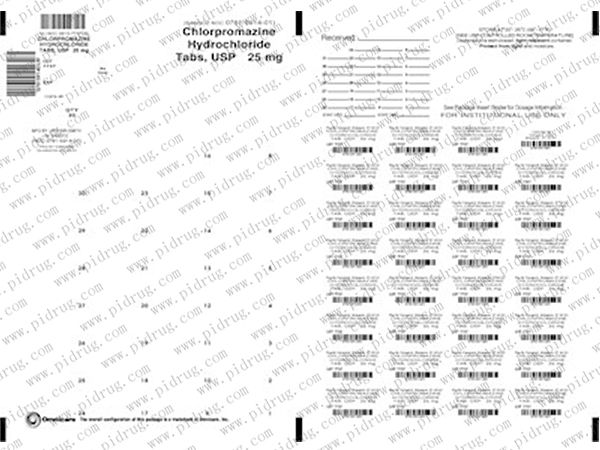药品详情:
【氯丙嗪chlorpromazine 简述】
本品系吩噻嗪类之代表药物,为中枢多巴胺受体的拮抗药,具有多种药理活性。

【氯丙嗪chlorpromazine 适应症】
①治疗精神病:用于控制精神分裂症或其他精神病的兴奋躁动、紧张不安、幻觉、妄想等症状,对忧郁症状及木僵症状的疗效较差。对Ⅱ型精神分裂症患者无效,甚至可加重病情。
②镇吐:几乎对各种原因引起的呕吐,如尿毒症、胃肠炎、癌症、妊娠及药物引起的呕吐均有效。也可治疗顽固性呃逆。但对晕动病呕吐无效。
③低温麻醉及人工冬眠:用于低温麻醉时可防止休克发生。人工冬眠时,与哌替啶、异丙嗪配成冬眠合剂用于创伤性休克、中毒性休克、烧伤、高烧及甲状腺危象的辅助治疗。
④与镇痛药合用,治疗癌症晚期患者的剧痛。
⑤治疗心力衰竭。
⑥试用于治疗巨人症。
【氯丙嗪chlorpromazine 规格】
本品为片剂,每片含有效成份25mg/50mg/100mg。
【氯丙嗪chlorpromazine 服用方法】
由于剂型及规格不同,用法用量请仔细阅读药品说明书或遵医嘱。
【氯丙嗪chlorpromazine 注意事项】
①肝功能不全、尿毒症及高血压、冠心病患者慎用,长期用药时应定期检査肝功能。
②本品刺激性大,静脉注射时可引起血栓性静脉炎,肌内注射局部疼痛较重,可加1%普鲁卡因作深部肌内注射。
③本品有时可引起抑郁状态,用药时应注意。
④6个月以下婴儿不推荐便用。
⑤老年人对本类药物的耐受性降低,且易产生低血压、过度镇静及不易消除的迟发性运动障碍。
【氯丙嗪chlorpromazine 不良反应】
①主要不良反应有口干、视物不清、上腹部不适、乏力、嗜睡、便秘、心悸,偶见泌乳、乳房肿大、肥胖、闭经等。
②注射或口服大剂量时可引起体位性低血压,用药后应 静卧1?2小时,血压过低时可静脉滴注去甲肾上腺素或麻黄碱升压。但不可用肾上腺素,以防血压降的更低。
③对肝功能有一定影响,偶可引起阻塞性黄疸、肝肿大,停药后可恢复。
④长期大量应用时可引起锥体外系反应,为抗精神病药物常见的不良反应。由于阻断多巴胺能纹状体黑质传导途 径产生震颤麻痹综合征、急性肌张力障碍、静坐不能等症状, 可用苯海索对抗之,但能降低疗效。本品还可引起一种特殊持久的运动障碍,称为迟发性运动障碍,表现为不自主的刻板运动,停药后不消失,抗胆碱药可加重此反应。
⑤可发生过敏反应,常见的有皮疹、接触性皮炎、剥脱性皮炎、粒细胞减少(此反应少见,一旦发生应立即停药)、哮喘、紫癜等。
⑥可引起眼部并发症,主要表现为角膜和晶体混浊,或使眼压升高。对长期使用者应作眼部检查,常规半年复查1次。高剂量应用本品时,夏季最好戴太阳镜以保护角膜和晶体。


Thorazine(chlorpromazine)
Chlorpromazine (CPZ), marketed under the trade names Thorazine and Largactil among others, is an antipsychotic medication.[2] It is primarily used to treat psychotic disorders such as schizophrenia.[2] Other uses include the treatment of bipolar disorder, attention deficit hyperactivity disorder, nausea and vomiting, anxiety before surgery, and hiccups that do not improve following other measures.[2] It can be given by mouth, by injection into a muscle, or into a vein.[2]
Common side effects include movement problems, sleepiness, dry mouth, low blood pressure upon standing, and increased weight.[2] Serious side effects may include the potentially permanent movement disorder tardive dyskinesia, neuroleptic malignant syndrome, and low white blood cell levels.[2] In older people with psychosis as a result of dementia it may increase the risk of death.[2] It is unclear if it is safe for use in pregnancy.[2]Chlorpromazine is in the typical antipsychotic class.[2] Its mechanism of action is not entirely clear but believed to be related to its ability as a dopamine antagonist.[2] It also has anti-serotonergic and antihistaminergic properties.[2]
Chlorpromazine was discovered in 1950 and was the first antipsychotic.[3][4] It is on the World Health Organization's List of Essential Medicines, the most effective and safe medicines needed in a health system.[5] Its introduction has been labeled as one of the great advances in the history of psychiatry.[6][7] It is available as a generic medication.[2] The wholesale cost in the developing world is between US$0.02 and US$0.12 per day.[8] In the United States the wholesale costs is about US$7.80 per day as of 2019.[9]
Medical uses
Chlorpromazine is classified as a low-potency typical antipsychotic and in the past was used in the treatment of both acute and chronic psychoses, including schizophrenia and the manic phase of bipolar disorder, as well as amphetamine-induced psychosis. Low-potency antipsychotics have more anticholinergic side effects, such as dry mouth, sedation, and constipation, and lower rates of extrapyramidal side effects, while high-potency antipsychotics (such as haloperidol) have the reverse profile.[10]
In a 2013 comparison of 15 antipsychotics in schizophrenia, chlorpromazine demonstrated mild-standard effectiveness. It was 13% more effective than lurasidone and iloperidone, approximately as effective as ziprasidone and asenapine, and 12-16% less effective than haloperidol, quetiapine, and aripiprazole.[11]
Chlorpromazine has also been used in porphyria and as part of tetanus treatment. It still is recommended for short-term management of severe anxiety and psychotic aggression. Resistant and severe hiccups, severe nausea/emesis, and preanesthetic conditioning are other uses.[10][12] Symptoms of delirium in hospitalized AIDS patients have been effectively treated with low doses of chlorpromazine.[13]
Other
Chlorpromazine is occasionally used off-label for treatment of severe migraine.[14][15] It is often, particularly as palliation, used in small doses to reduce nausea suffered by opioid-treated cancer patients and to intensify and prolong the analgesia of the opioids as well.[14][16]
In Germany, chlorpromazine still carries label indications for insomnia, severe pruritus, and preanesthesia.[17]
Contraindications
Absolute contraindications include:[1]
§ Circulatory
§ CNS depression
§ Coma
§ Drug intoxication
§ Bone marrow suppression
§ Phaeochromocytoma
§ Hepatic failure
§ Active liver disease
§ Previous hypersensitivity (including jaundice, agranulocytosis, etc.) to phenothiazines, especially chlorpromazine, or any of the excipients in the formulation being used.
Relative contraindications include:[1]
§ Epilepsy
§ Parkinson's disease
§ Myasthenia gravis
§ Hypoparathyroidism
§ Prostatic hypertrophy
Very rarely, elongation of the QT interval may occur, increasing the risk of potentially fatal arrhythmias.[22]
Adverse effects
There appears to be a dose-dependent risk for seizures with chlorpromazine treatment.[19]Tardive dyskinesia (involuntary, repetitive body movements) and akathisia (a feeling of inner restlessness and inability to stay still) are less commonly seen with chlorpromazine than they are with high potency typical antipsychotics such as haloperidol[20] or trifluoperazine, and some evidence suggests that, with conservative dosing, the incidence of such effects for chlorpromazine may be comparable to that of newer agents such as risperidone or olanzapine.[21]
Chlorpromazine may deposit in ocular tissues when taken in high dosages for long periods of time.
注:药品如有新包装,以新包装为准。以上资讯来源于网络或由高等医药院校的学生志愿者翻译(如有错漏,请帮忙指正),仅供医护人员内部讨论,不作任何用药依据,具体用药指引,请咨询主治医师。
如您发现本网站有文字编辑或内容错误,请点击此处发送(需要安装有foxmail或outlook支持),
或发邮件至:info@pidrug.com,香港济民药业感谢您的到访!
欢迎您添加香港济民药业微信,或在公众号内留言。



